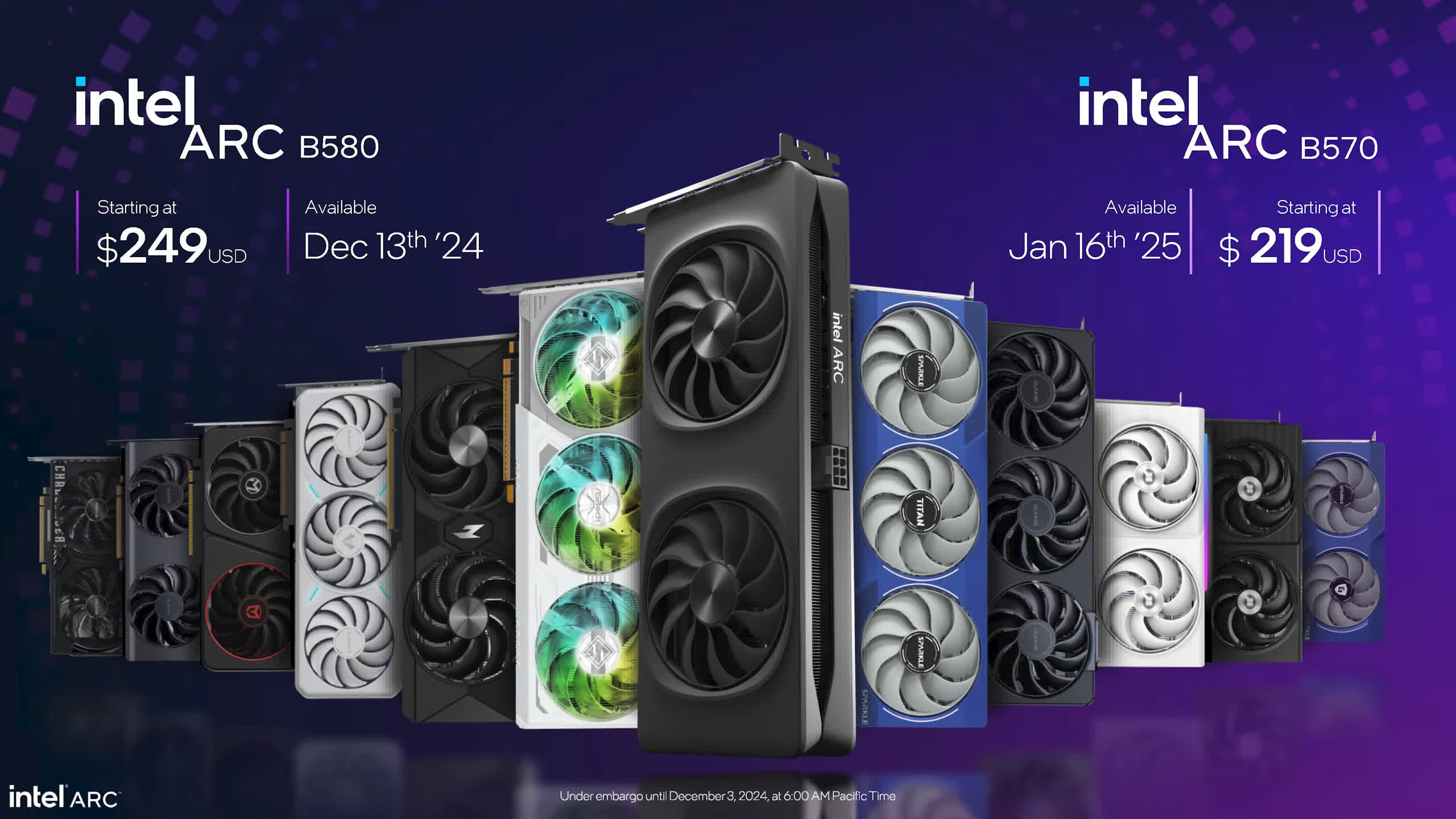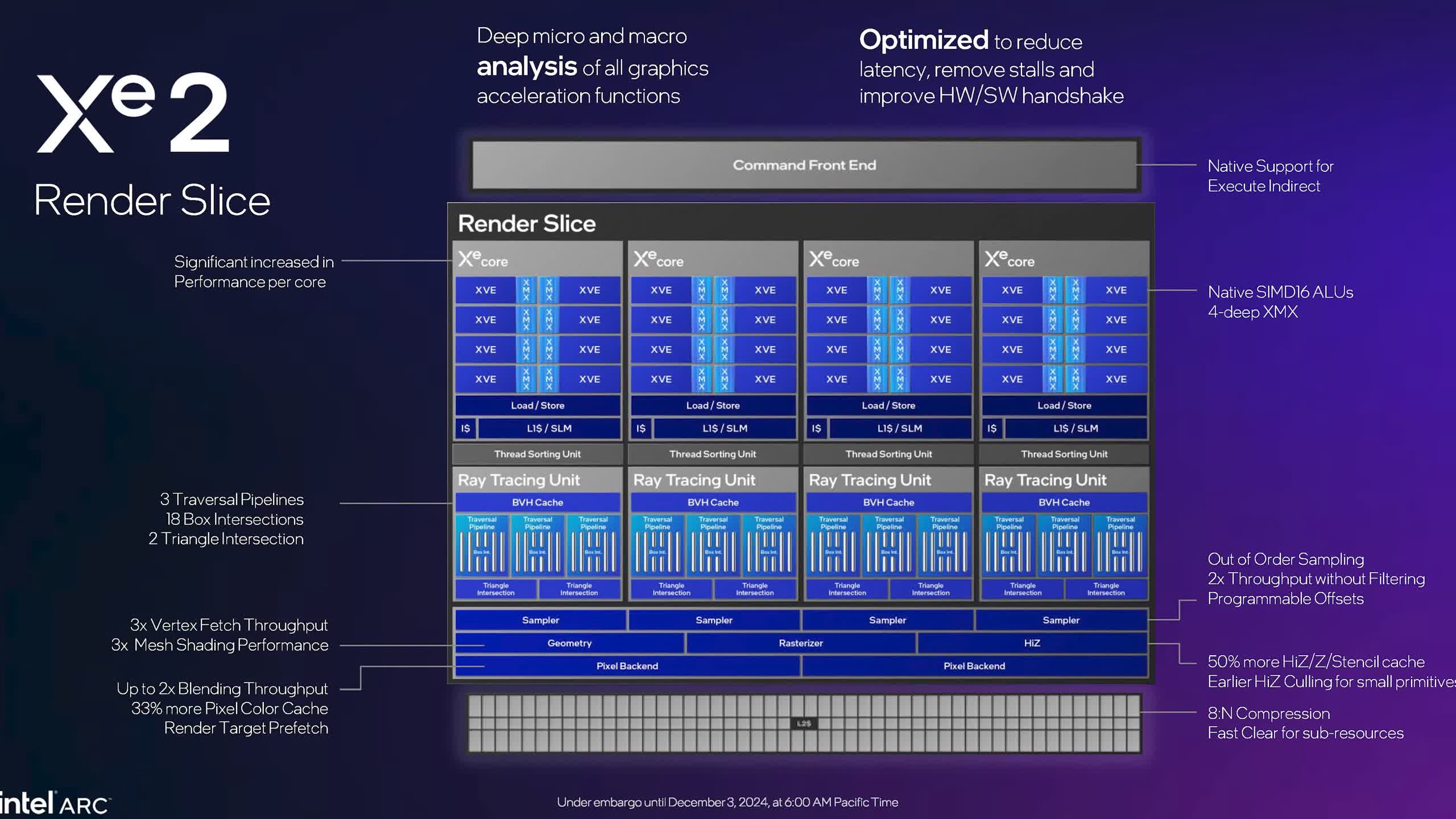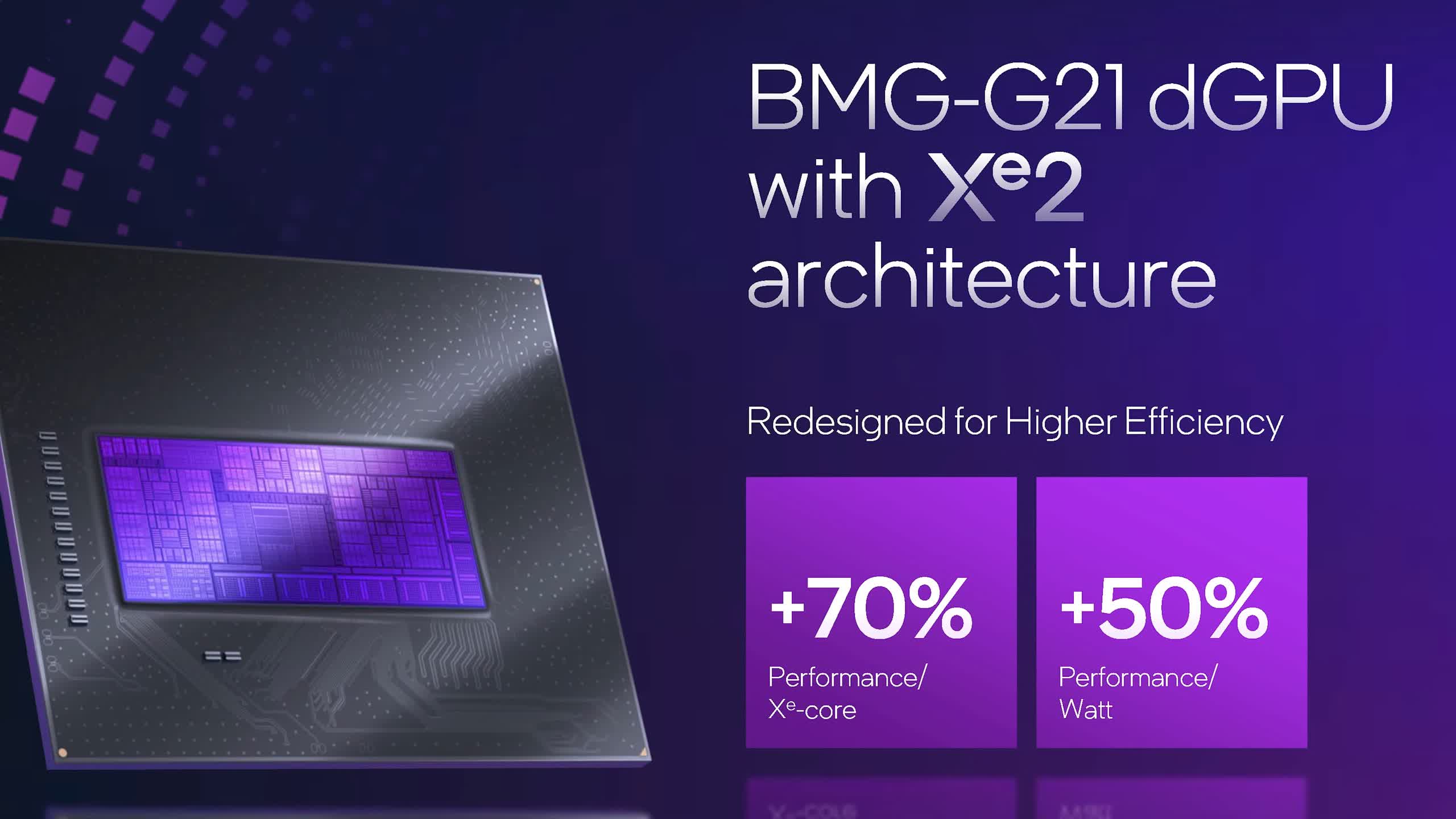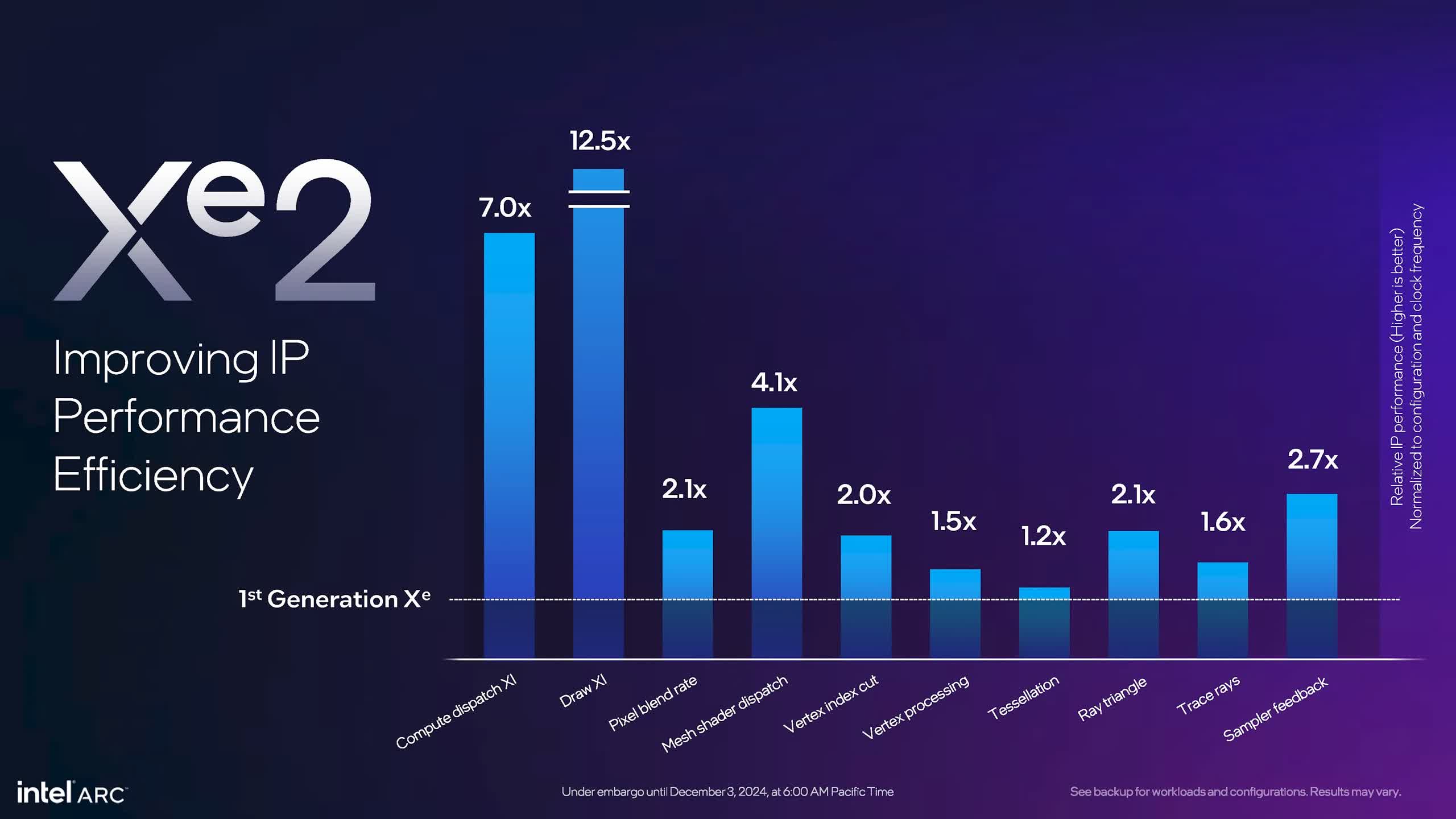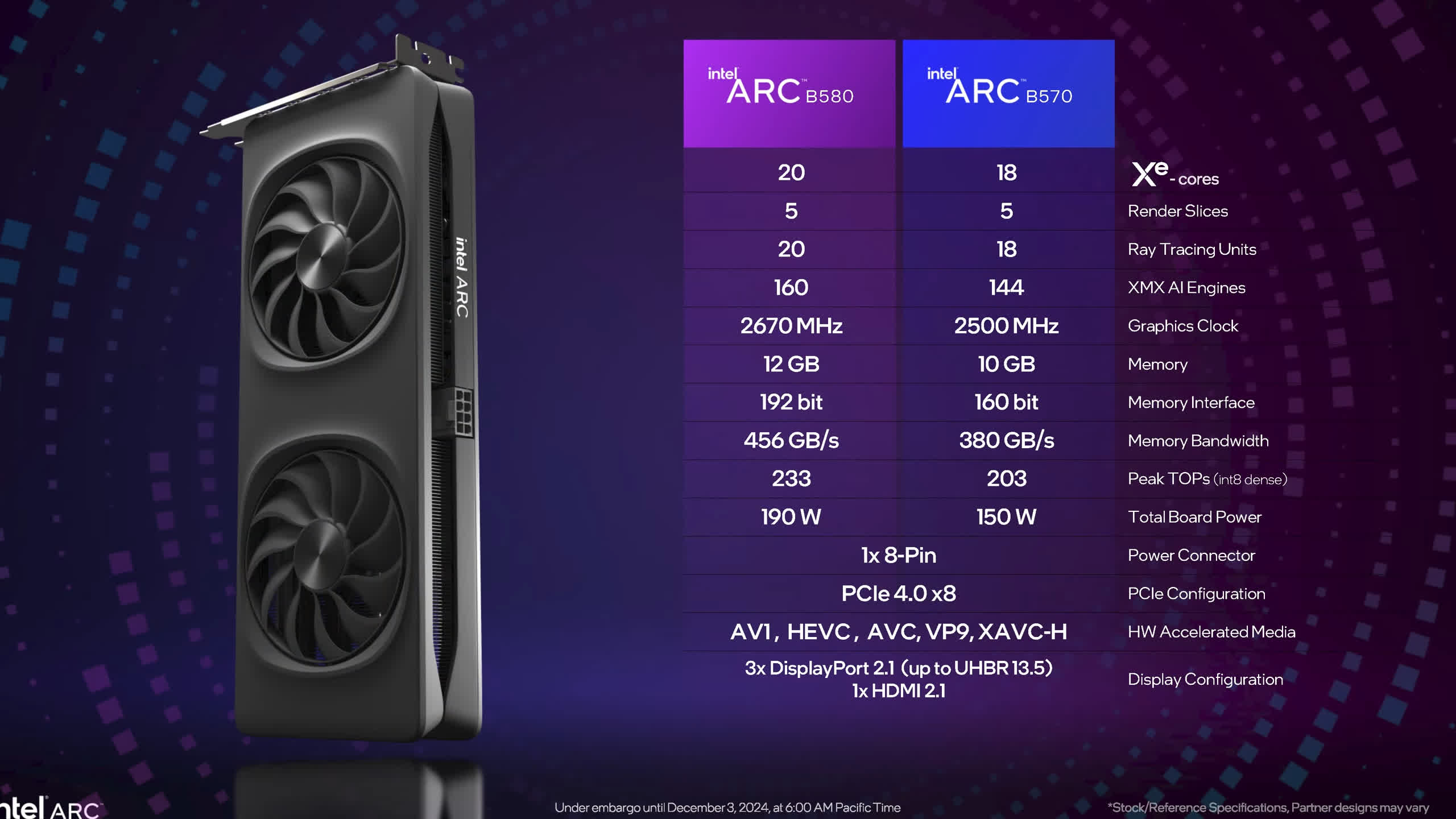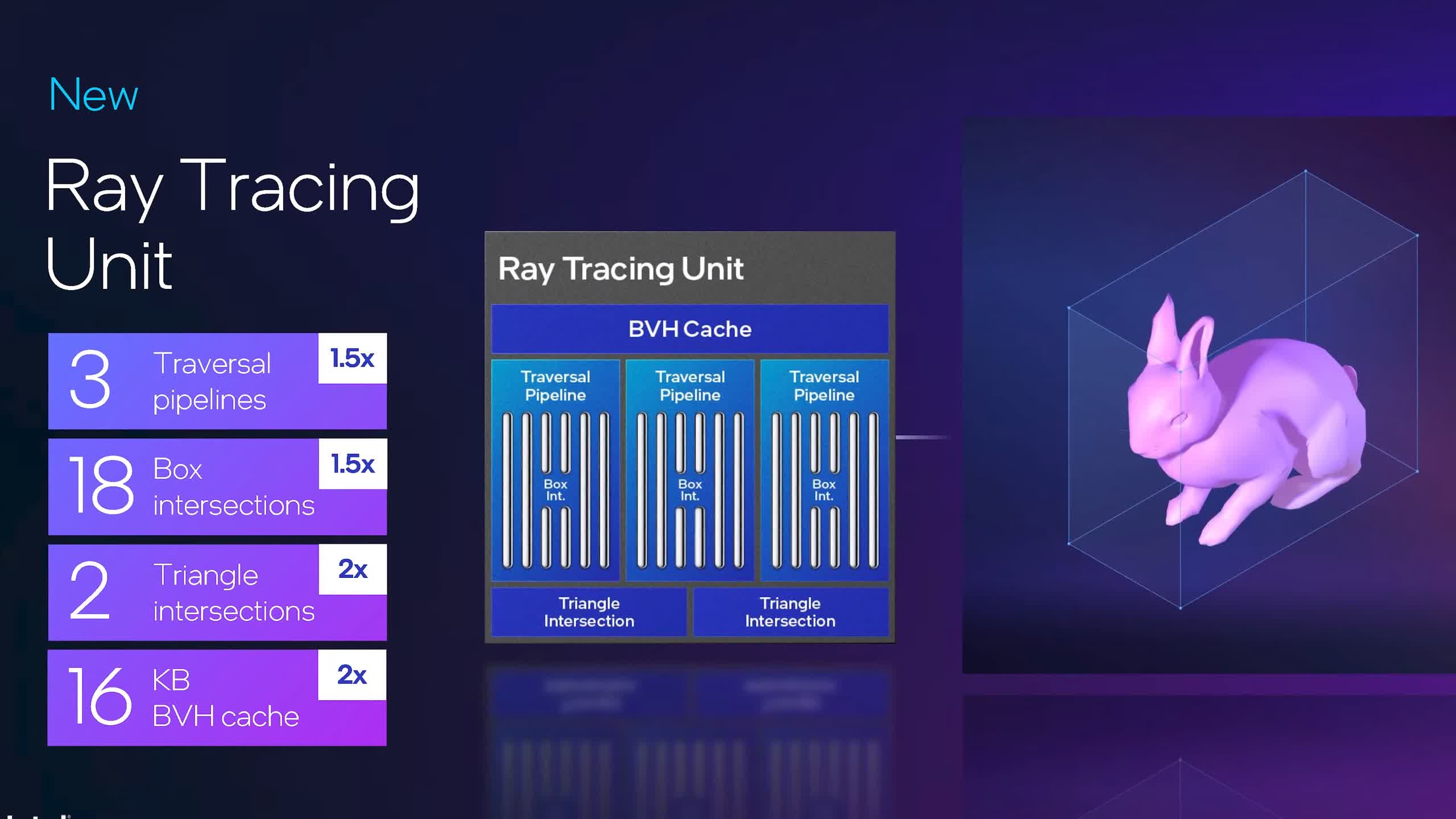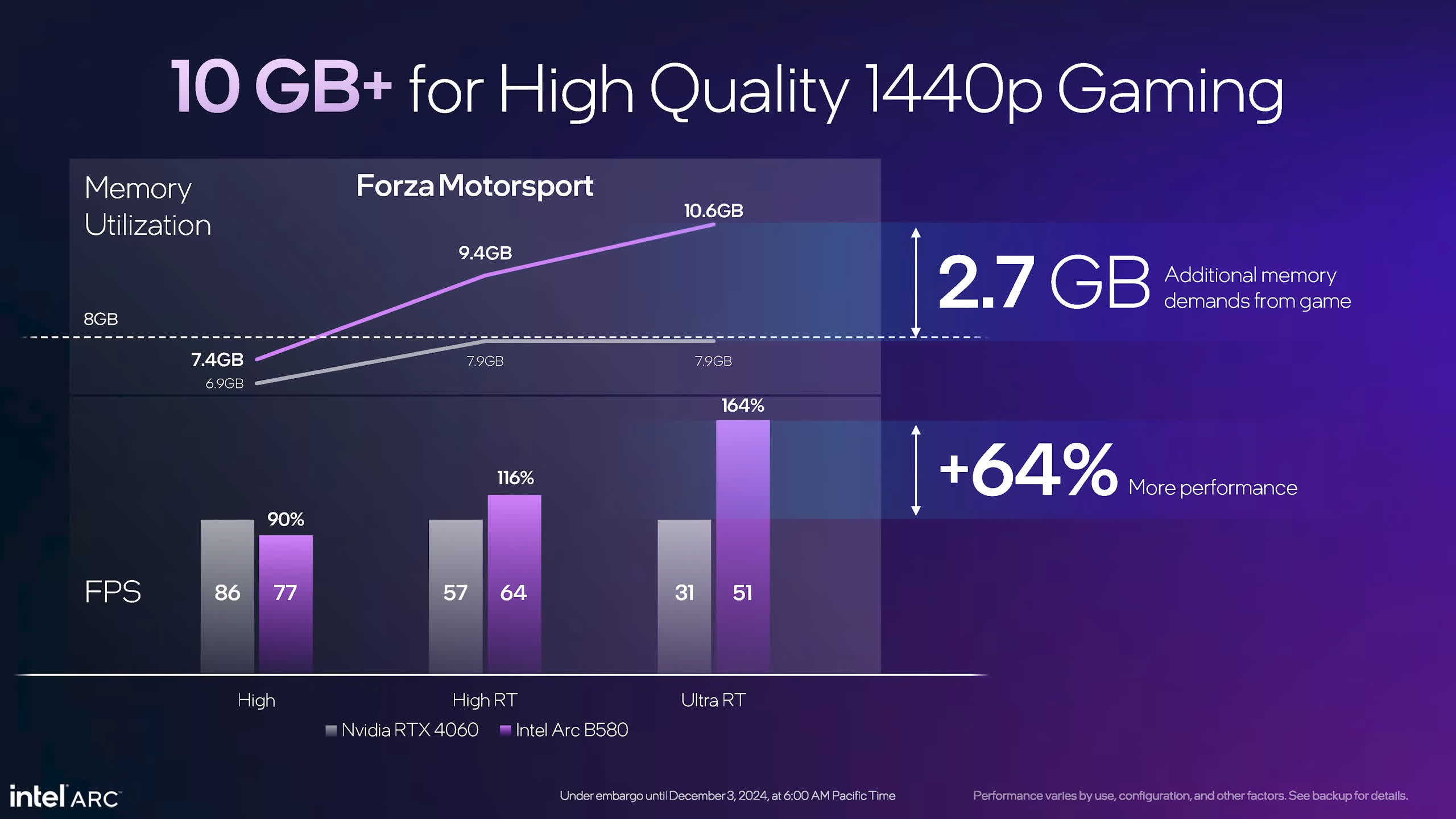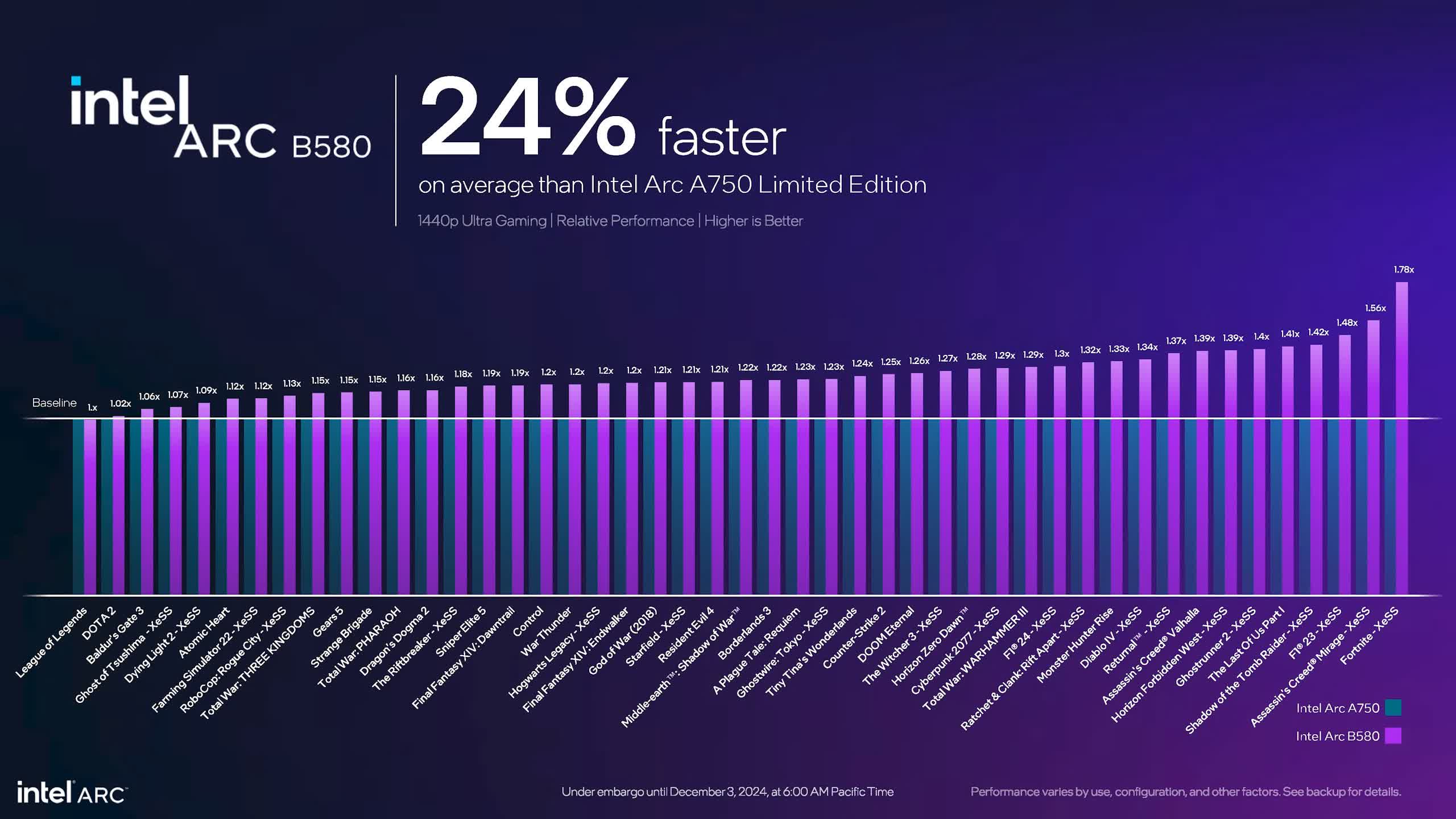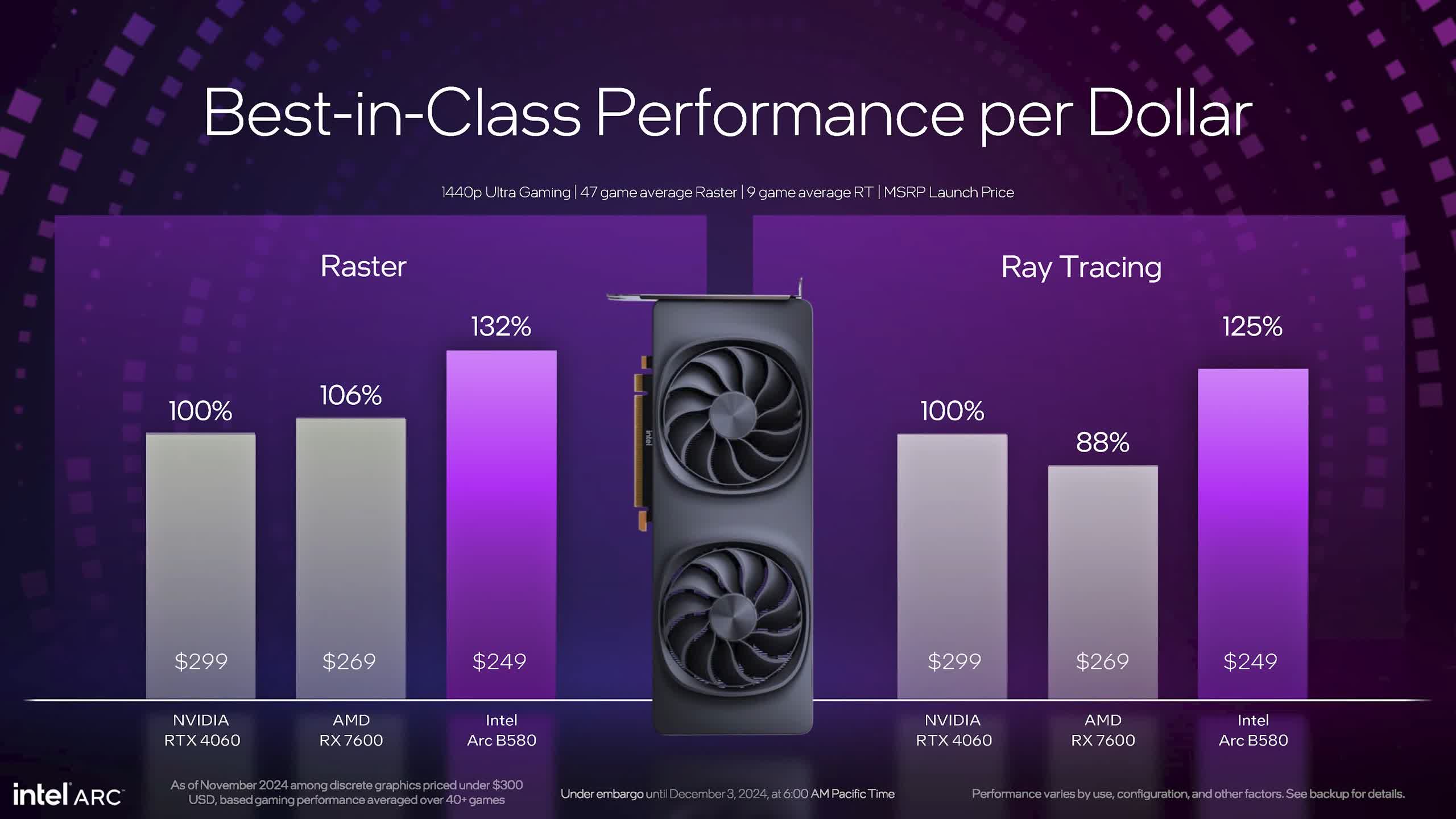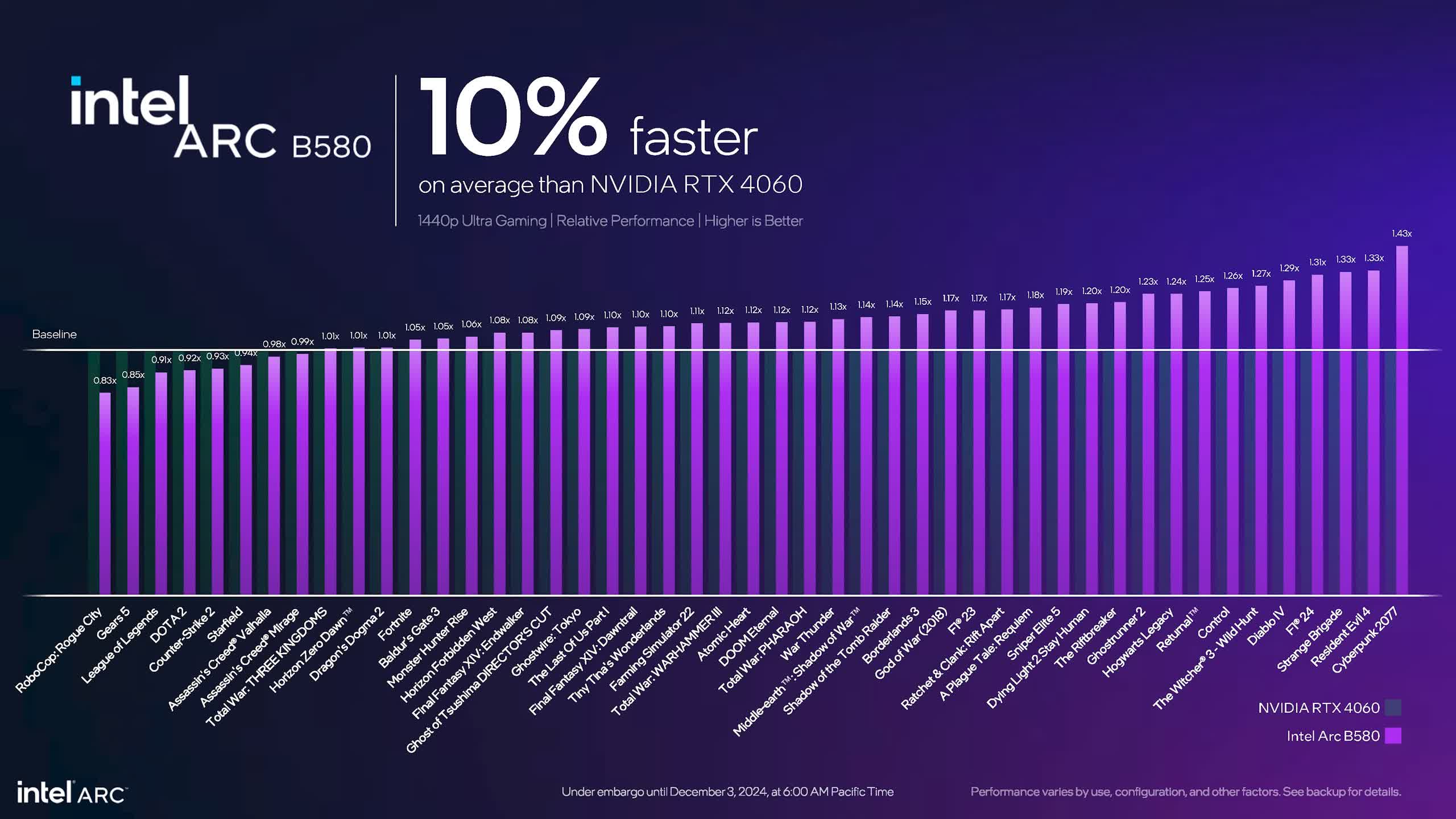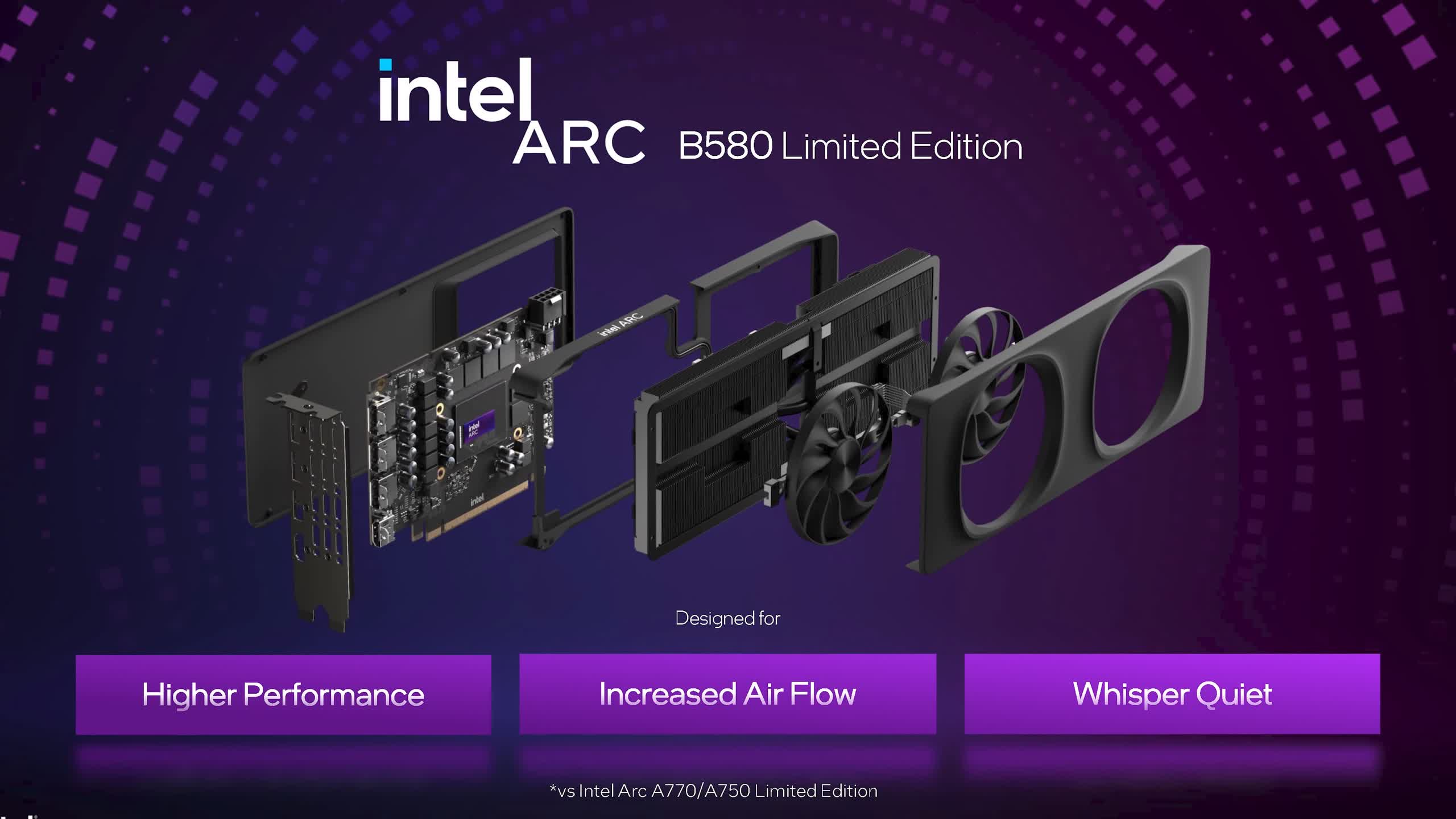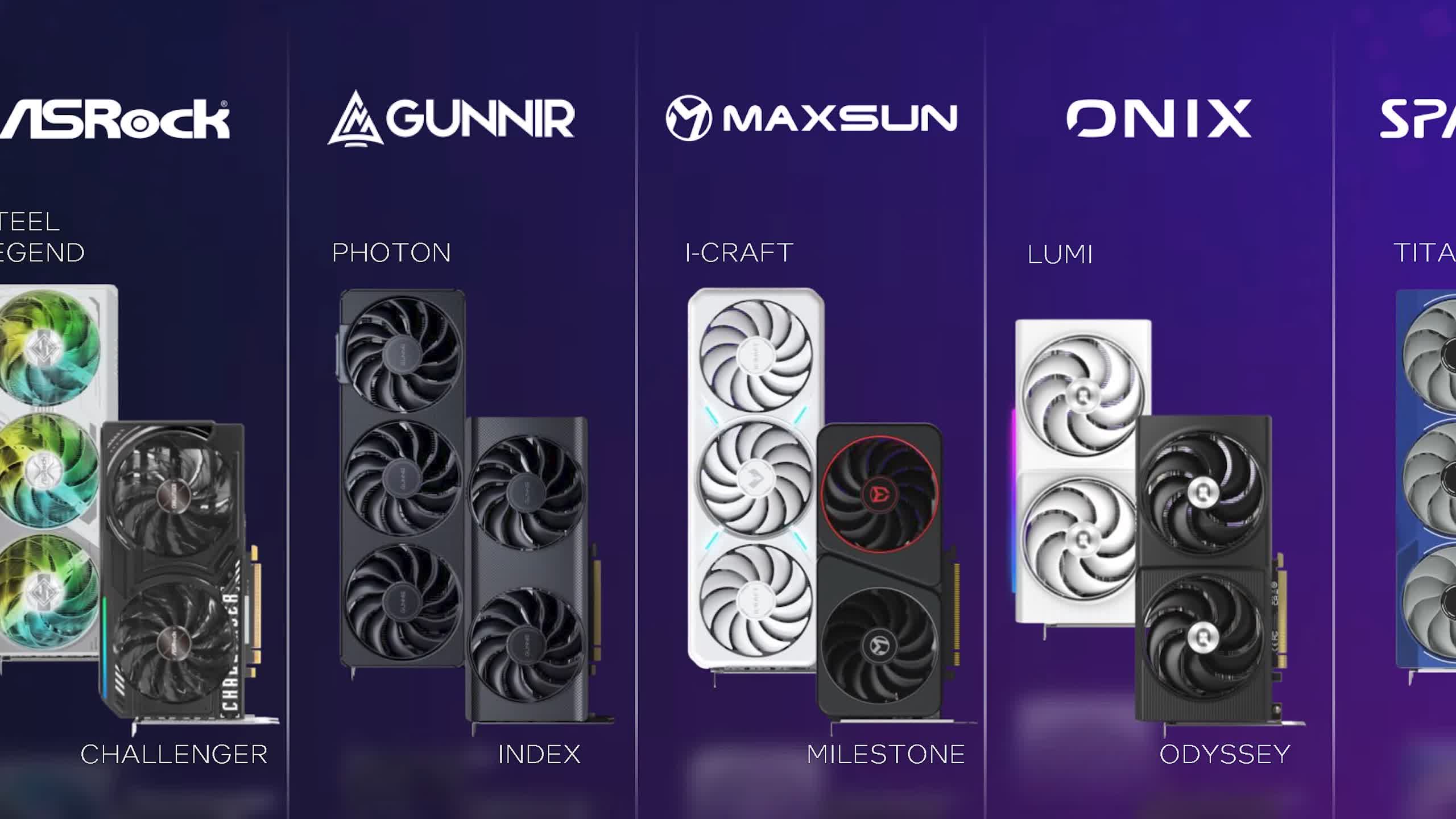Forward-looking: Intel is finally ready to announce its next-generation Battlemage gaming GPUs today, beginning with the Arc B580 and Arc B570. We've got all the details: specs, performance claims, pricing, and even the announcement of XeSS 2 – so what does Intel have in store for the GPU market?
The Intel Arc B580 will be available starting December 13th for $250, while the Arc B570 will come a bit later, on January 16th, for $220. These GPUs are targeting mainstream, affordable price points. That's where they're starting out with Battlemage, but these are not necessarily the highest-tier, fastest cards Intel will offer.
With Alchemist, the previous-generation A series, the "500" tier of cards was in the middle of Intel's lineup, with the more powerful A770 and A750 sitting above. The naming scheme for the cards Intel is announcing today implies something similar: these are mid-tier models in Intel's lineup, and hopefully, we'll learn about the flagship B700 series at some point in the future.
Xe2 Battlemage architecture
The Arc B580 and B570 use Intel's greatly overhauled Xe 2 architecture. This new design features significant improvements everywhere, from the front end to the shader units to the ray tracing units, with the goal of lifting performance per core.
Intel is claiming a 70% performance improvement per Xe Core, along with a 50% performance-per-watt improvement.
Ultimately, Intel is claiming a 70% performance improvement per Xe Core, along with a 50% performance-per-watt improvement. Some of this advantage comes from the shift to TSMC's N5 process technology, compared to TSMC N6 for Alchemist, but a significant portion of this uplift comes from architectural changes, enhancements, and fixes.
For example, in this chart, you can see how Xe 2 delivers significant gains to areas like dispatch, draw call performance, ray tracing effects, and sampler feedback relative to Xe 1, normalized to configuration and clock frequency. Some of these gains are so large they point to huge architectural weaknesses in Xe 1 that have been fixed in Xe 2, and this should lead to fewer games that struggle on Battlemage.
What Intel is announcing today is the BMG-G21 GPU die, which is used for both the Arc B580 and Arc B570 graphics cards. This GPU, in its maximum configuration, has five render slices for a total of 20 Xe cores, 20 ray tracing units, and 160 XMX engines. There's also 18MB of L2 cache and a 192-bit GDDR6 memory interface. This design is fully unlocked in the B580, while there's a 10% cutback in core count for the B570.
Intel Arc B580 and Arc B570 specifications
There are a few interesting aspects to this design from a hardware configuration perspective. With a massive overhaul in architecture, Intel has cut back the number of cores in the B580 relative to previous models. Just 20 Xe cores is fewer than the 24 in the A580 and a lot fewer than the 32 cores seen in the A770. But these cores benefit from not only that architectural overhaul but also much faster clock speeds.
The A580 was clocked at just 1,700 MHz and the A770 at 2,100 MHz, but the B580 is clocked at 2,670 MHz. That's a whopping 57% increase over the A580's clock and a 27% increase over the A770.
On the other hand, the memory subsystem isn't as strong. The A770 and A580 both featured a 256-bit memory bus, but on the B580, that's been reduced to 192-bit. Intel has somewhat compensated for this with faster 19 Gbps GDDR6 memory compared to 16 Gbps or even 17.5 Gbps previously, but that still results in less memory bandwidth: 456 GB/s versus 512 GB/s on the A580, an 11% reduction.
The benefit of going with 192-bit instead of 256-bit is that it opens up more "sensible" VRAM configurations. Instead of being stuck with an unsatisfactory 8GB or a more expensive 16GB configuration, Intel is offering the B580 with 12GB, which splits the middle and should be enough for this class of graphics card.
It's certainly far superior to 8GB, which is quickly becoming insufficient even for mainstream gaming. With Intel positioning these models for 1440p gaming, they are well aware that 12GB of memory is actually useful on this sort of card.
The B580 also comes with a 190W total board power rating, which is 15W higher than the B570 and 35W lower than the A750. It's the same rating as the Radeon RX 7600 XT from AMD but higher than that of the GeForce RTX 4060 Ti. Cards will come with a single 8-pin PCIe connector, a PCIe 4.0 x8 interface, HDMI 2.1, and DisplayPort 2.1 UHBR13.5.
The B570 is a cut-down version, with a 10% reduction to the core configuration, bringing it to 18 Xe Cores. Clock speeds are also 6% lower than the B580, at 2,500 MHz. Meanwhile, the memory subsystem gets a larger cut: the interface is reduced to 160-bit, and this means Intel has paired it with 10 GB of memory, which is still better than the 8 GB seen in this tier today. Total bandwidth is 17% lower than the B580, at 380 GB/s.
Performance claims (Intel's own testing)
Where does all of this leave performance? That's the big question going into any significant architectural overhaul. Well, the following claims are based on Intel's first-party testing, so as always, take them with a grain of salt, but this is where Intel believes the B580 will slot in.
The comparison Intel is making between Alchemist and Battlemage is the battle between the A750 and B580. Despite having a "tier lower" name, Intel claims the B580 will be 24% faster on average across a 47-game sample, some of these titles with XeSS enabled, as you can see in the chart.
This should put it ahead of Intel's previous-gen fastest model, the Arc A770, and that's despite it having 38% fewer Xe cores. The combination of the architectural gains and a 27% clock speed increase is able to offset the reduction in core count and memory bandwidth. Most of the titles shown here are able to hit 60 FPS or more using 1440p Ultra settings.
Intel is also claiming substantial gains over older products, in particular the five-year-old GeForce GTX 1660 Super, which launched at $230 in October 2019.
For $250, Intel suggests the B580 is 96% faster, while also supporting hardware-accelerated ray tracing and newer upscaling tech like XeSS using Intel's superior XMX pathway.
When it comes to current-gen models, Intel claims the B580 is 10% faster than the GeForce RTX 4060 for 1440p Ultra gaming. This correlates well with our testing for the A750 and Intel's claims relative to that part. A 24% uplift over the A750 and a 10% uplift over the 4060 would lead to a similar average result in our 1440p performance charts, around the level of AMD's Radeon RX 7600 XT.
There were some rumors that the B580 would perform more like an RTX 4060 Ti, but those don't appear to be accurate: the B580 falls between the 4060 and 4060 Ti according to Intel's testing, though closer to the 4060 end of that range.
Value analysis on Intel's new GPUs
We have quite a few initial thoughts on this performance and pricing. Of course, this is again based on Intel's claims, which we're assuming represent a best-case scenario. If performance does fall around the level of an RX 7600 XT, Intel is effectively offering that level of performance for about $60 – $70 less than current 7600 XT prices, which are typically around $310 or $320. That's about a 20% reduction in cost for that level of performance, which is okay – it's reasonable.
It would also mean you're getting more performance and more VRAM than the RTX 4060 at $50 less, which Intel says should lead to 32% better performance per dollar in rasterization and 25% better in ray tracing.
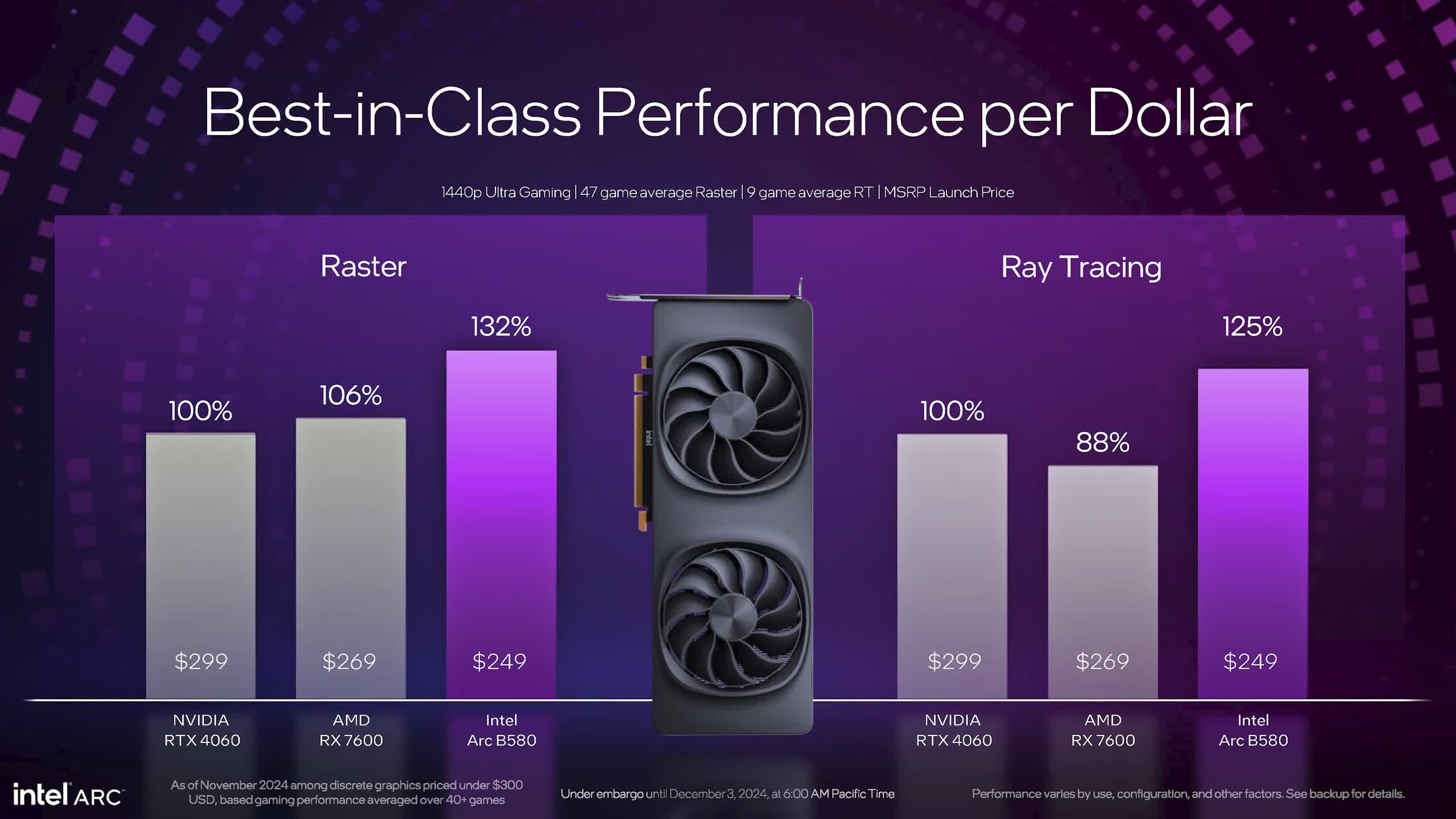
Intel provides similar numbers relative to the RX 7600, of course, with the 7600 being a little stronger in raster, weaker in ray tracing, and also featuring just 8 GB of VRAM. That value proposition relative to current-generation models again looks reasonable, and Intel mentioned in their briefing that they are committed to making these cards the best value on the market.
Our gut feeling is this falls short of being great or outstanding value, and there are a few reasons for this. We polled you, our audience, a few days ago asking what the maximum price you'd consider paying for a hypothetical B580 GPU that offered performance near the level of an RTX 4060 Ti, and 44% of you said $250, with 25% saying $300 and 18% saying $200.
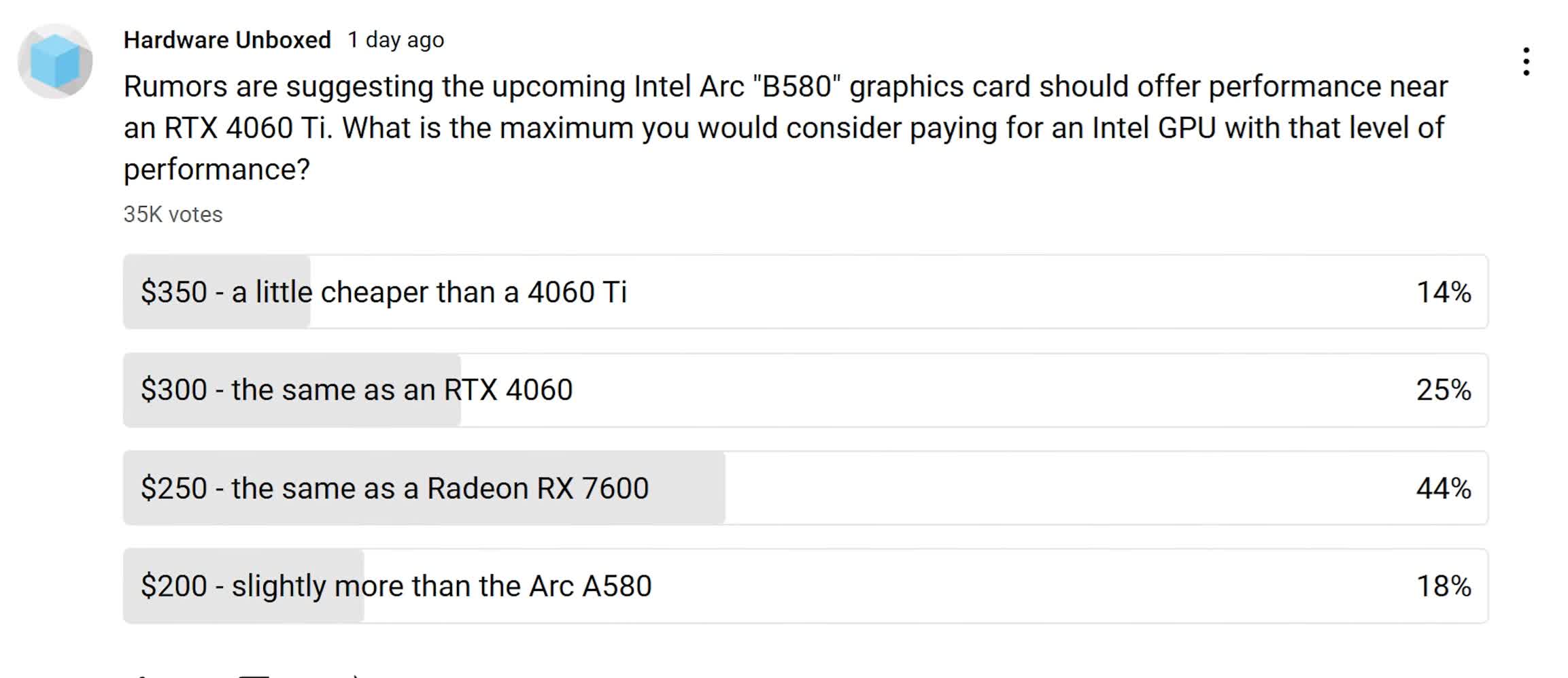
What we now know is that the B580 is closer to the 4060 than the 4060 Ti, based on Intel's claims. So if GPU buyers would only be willing to pay $250 for 4060 Ti levels of performance, the B580 might feel a bit underwhelming.
The general sentiment in the comments was that people were only willing to buy an Intel GPU at this sort of value proposition because of the uncertainty around drivers. Arc GPU drivers have come a long way since the early days of the A770, and with this release, Intel is boasting about continuous software improvements.
But until Intel has a proven track record with GPU drivers, gamers will likely hesitate to buy an Intel GPU unless it's at a significant discount – and we're not sure the B580 at $250 would qualify as a significant discount. Of course, we'll provide an update on game compatibility in our full review of the Arc B580 when we get to testing it very soon.
Another factor is the prospect of incoming next-generation Nvidia and AMD GPUs. We're not sure how long it will be until we see next-gen products from those companies targeting the sub-$300 price range, but new products are coming very early in 2025.
The RTX 4060 that Intel compared the B580 to is nearly 18 months old, and it's a similar story with the RX 7600. While pricing might look okay relative to current-generation models at the end of their product cycle, it remains to be seen whether this level of value is good enough to fend off new products from the two main GPU brands.
Intel will need to continue offering this level of value relative to AMD and Nvidia even after new products are launched if they want to build market share. We suspect this could mean price cuts down the line. Intel may only be able to benefit from launching first and offering superior value in the current market for a few months before competition heats up.
The Arc B570 is also in a weird position. It's launching a month later for $220, which is 12% less than the B580. However, if you look at the hardware specs, it has 10% fewer cores clocked 6% lower, and it has 17% less memory bandwidth and VRAM. We don't have any performance claims for this model, but the hardware configuration points to more than a 12% reduction in performance relative to the B580 – so it could be a situation where the B570 is worse value despite being lower in the product stack.
Again, we think the pricing of $250 for the B580 and $220 for the B570 is going to look decent compared to current, soon-to-be last-generation cards. But to really build market share, fend off new GPUs, and make it very hard to overlook an Arc Battlemage card, pricing would have to be more aggressive. Time will tell on that one, and of course, we'll have to see where performance and value lie in our review.
Intel Arc B580 Limited Edition
The Arc B580 will be available as a limited edition model from Intel directly, similar to a Founders Edition or "reference model." Intel says this new design has been optimized for increased airflow and performance relative to the A770 Limited Edition, with a similar overall aesthetic.
These cards will also be available from a variety of board partners, including brands seen previously such as Asrock, Gunnir, and Sparkle. Intel has yet to convince the biggest vendors like Asus, MSI, and Gigabyte to get involved, but there are more OEMs now than at the launch of Alchemist.
That's all the information we have about Battlemage hardware for now. On a separate story we have covered XeSS 2 which also launched today. The next version of XeSS adds frame generation and a low-latency mode, similar to what we've seen from Nvidia with DLSS 3 frame generation and Reflex, as well as AMD with FSR 3 frame generation and Anti-Lag 2.
Intel is staying tight-lipped on their plans for future B-series products, so hopefully, this is just the beginning. It's good to see a focus on value for the B580 and B570, given that the lower parts of the graphics card market have been badly neglected over the last few years. Fingers crossed it lives up to expectations when we get to testing it over the next week or so.
